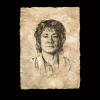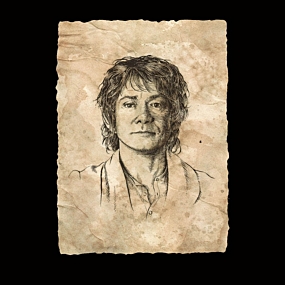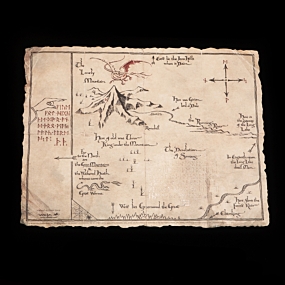Sorry, have overlooked this question before. We were talking about rag paper - among others. Rags were fabric before. So to check what kind of rags elves would have available would be to know what fabrics they had available to get ragged enough to be made into paper.
Correct, that conversation is on topic for this thread. Other discussions about fabric belong more appropriately in the Costumes forum.
As for the color of the paper...I do not think that all paper need be bright white. Certainly, there are situations where grey paper or brown paper could be useful, and I see no problem with depicting that on the show.
If the paper does need to be white, it could still be an off-white shade to denote its origins.
If bleaching is required, it could occur during the paper-making, true, but it could also occur when the fabric is made (in the case of rag paper) or after the paper is made. The Elves have been able to make white clothing ever since they reached Valinor (in fact, the Vanyar show a strong preference for it in our show). And as has been pointed out, the sun is great at bleaching materials out if you are clever enough to make use of that property.
As for the texture - yes, homemade paper tends to be very rough. One reason why is that homemade paper is not typically pressed to achieve smoothness. I think that adding a pressing step would make the paper a more useful product. Other steps to finish the paper could be included as well.
I do like the suggestion of a 'Valinorean paper tree'! That fits with Valinor having plants and animals that are not seen in Middle-earth.
Would elves gather enough rags to have a high volume paper production? (Do elves actually use linen? Do elves have access to cotton (this would have to be imported from afar). Do elves keep sheep to make wool? Do they make wild silk?)
What type of volume are you imagining? I certainly wasn't picturing a booming paper trade! Rather, that they can make and use paper, so they do, but they aren't wasteful and simply make what they need. Clothing naturally has a much shorter lifespan than do elves, so all of their clothing would eventually become rags. A method to recycle this material into something else that is useful would likely be appealing to the elves. No doubt they would use magic to preserve their clothing a little longer than expected (or in some rare cases, maybe indefinitely - like for Thingol's grey cloak from Valinor). But in general, yes, elves would have some quantity of rags to be recycled available in their communities.
Elves at Cuiviénen, the Avari, and the Elves on the journey to Valinor all wore clothing woven from plant-based fibers in Silm Film Season 2. So, presumably yes to the linen and flax. They did not make use of silk until they reached Valinor, but certainly post-Season 2 the Noldor have silk, yes. We haven't mentioned sheep specifically, I don't think, but I imagine wool is available in Beleriand. We did mention alpacas as possible animals the Noldor would have had with them when they started crossing the Helcaraxë (see the Season 3 Episode 9 Script Outline). While cotton could exist in Valinor, I don't think we've pictured it existing in Beleriand.
[Do elves use magic for retting? Flax and other plant fiber retting is a nasty, smelly and environmentally harmful process - I propose humans to be the ones doing it and elves buying spin-ready flax roving from the humans]. ...I also propose humans to be parchment makers. Hide processing is also a nasty process the humans would not be above. And humans keep domesticated animals that they do process. Vellum is basically fine parchment - just made of calfskin.
The process of retting removes the pectin from the fibers. It is possible that the elves use an enzymatic retting process rather than the traditional 'soak it in a pond for two weeks' method. If you think this version is more pleasant, it can be the basis for the magical elven retting. But the environmental impact is, on some level, a matter of scale. Elves can reduce that impact by not producing a large volume of material (whether that be flax or paper). As for the fact that it stinks - temporarily, yes. The paper doesn't stink.
I maintain - strongly and emphatically - that the Noldor are indeed chemists, and that their skill in this field rivals the Dwarves. There are differences in approach between them, and not a complete overlap, but it is simply not the case that all Elves would 'avoid' such things - because how else did the Noldor master metallurgy? They have had steel since Valinor. And they need not 'break a thing to find out what it is' - they can gain knowledge of how the world is made directly from Aulë in all the years he tutored them in Valinor. Science, knowledge of the world, (as opposed to technology or applied knowledge) is a pursuit the Valar (or at least Aulë, anyway) encourage. Understanding the natural world is something all Elves seem to have a strong affinity for, but in the Noldor, that takes the form of being master chemists (among other things).
The main issue with using humans as the primary source of materials for the Noldor is that they enter First Age Beleriand so late in the story. In Silm Film, Finrod meets Bëor in FA 340, and then the people of Bëor move to Nargothrond, adopting the lifestyle of the elves of Nargothrond in part. Fingon takes Hador into his service in FA 392. So, sure, the humans could make supplies that the Elves would trade with them for, but in these cases, the Elves were supplying themselves for hundreds of years before the humans arrived. And in Gondolin, no trade with humans or Dwarves is possible, yet we know they have books. Pengolod is a character in our story. As was Rúmil in Season 2. So, while it is possible that flax is grown and processed in, say, Dor-lómin and then flax roving is traded to other places...I would find it hard to believe that the Elves lacked a source of processed flax prior to that time because...the process of making it is too distasteful?
Also a reminder that Elves in Silm Film are not vegetarian. They do hunt, eat meat, and process leather hides themselves. They raise horses, and presumably keep other domestic animals. The Elves who crossed the Helcaraxë wear fur as a significant reminder of that experience. Aredhel's fur cloak (made for her by her Fëanorean cousins) features in Seasons 4 &5. It's true that they don't typically make their clothing out of hides, but making parchment is not something outside the pale of what they would do. It is the Dwarves who are naturally uninclined to animal husbandry.
As such I propose to have "Orodreth's documents" contain a variety of mediums, shades and styles.
Rather, I think it would make sense to consider the material of each prop, and some variety may exist within our show. I don't think Orodreth has a stack of different materials in various shades sitting on his desk. He would likely have one or two, in whatever quantity he needs. But we could reach a different conclusion about the material used for Aredhel's pop-up book that she constructs for Maeglin in Season 5, or the copy of Lúthien's song written down by Daeron and gifted to the dwarves of Belegost in Season 3. Since most materials are going to be made where they are being used, there can be a lot of variety in how things are made from place to place.











